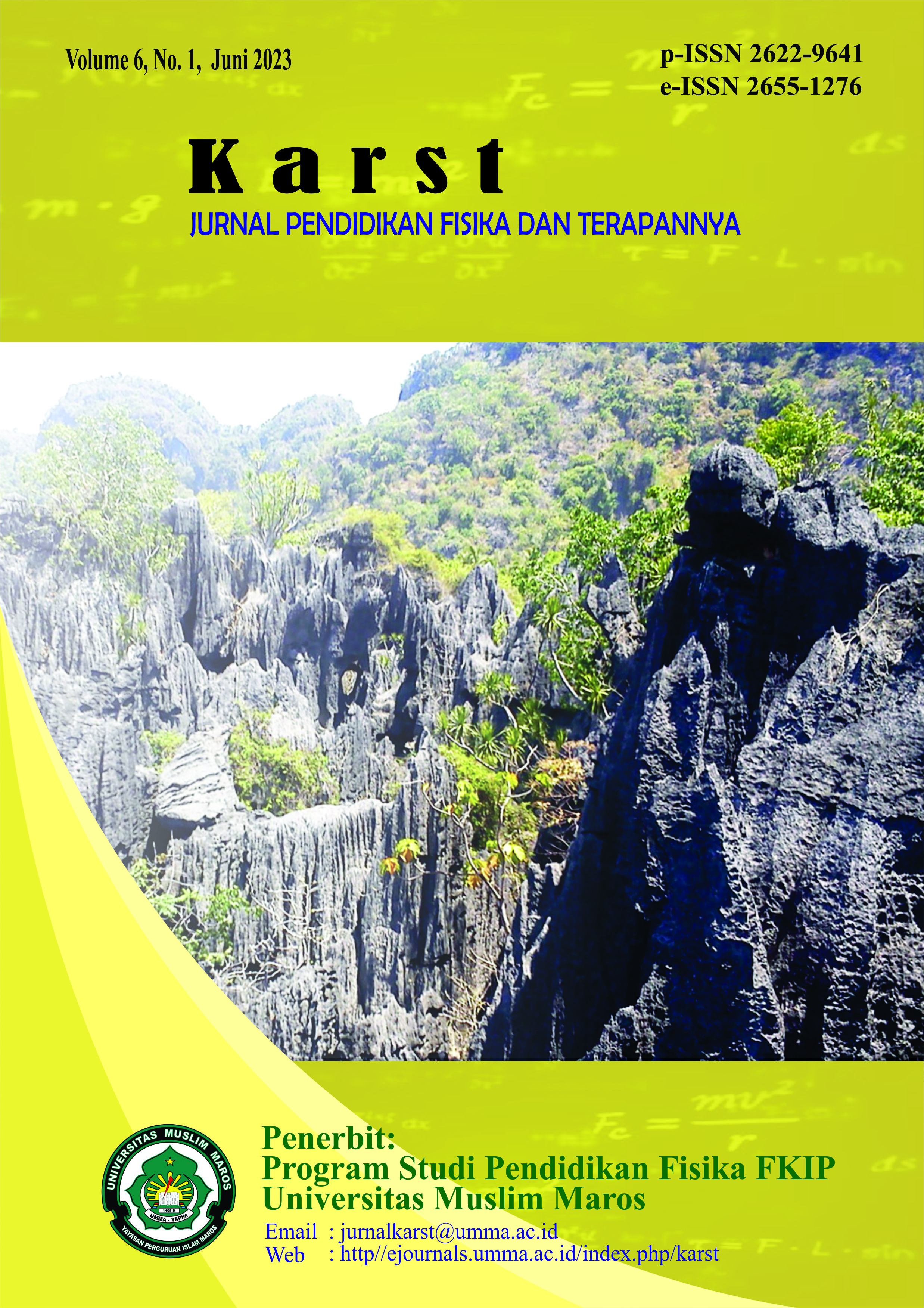PEMAHAMAN KONSEP SISWA MELALUI SKEMA BLENDED LEARNING MENGGUNAKAN LEMBAR KERJA BERBASIS SIMULASI
DOI:
https://doi.org/10.46918/karst.v6i1.1724Keywords:
conceptual understanding, blended learning, simulation, vector, projectile motion, pemahaman konsep, simulasi, vektor, gerak parabolaAbstract
Learning, especially in physics, could be done in a combination of face-to-face and online. However, the scheme of this combination is unclear. Both type of learning need to be synchronized so that learning becomes effective. The solution is to involve technology in the learning process. Technology can be used as a learning medium and assessment. Blended learning scheme using worksheet based on PhET (Physics Education Technology) simulation was applied in Basic Physics course. This solution is expected to create link between face-to-face and online learning. Mixed methods with embedded design was applied. The population is quite small, namely 32 students so that all population is applied as a sample. Data on students' conceptual understanding were collected using a test. Class discussions became the basis for qualitative data which was further explored through interviews. Conceptual understanding was found in the high category for vector and projectile motion when taught through a blended learning scheme using student worksheets. The averages scores for vector in 1 dimension and 2 dimensions are 85.94 and 77.93, respectively. Then the average scores for the projectile motion is 80.93. Furthermore, through discussions and interviews, various misconceptions and their causes.
References
Adams, W. K., Paulson, A. and Wieman, C. E. (2008) ‘What levels of guidance promote engaged exploration with interactive simulations?’, AIP Conference Proceedings, 1064, pp. 59–62. doi: 10.1063/1.3021273.
Barbour, M. K. et al. (2020) ‘Understanding pandemic pedagogy: differences between emergency remote, remote, and online teaching’, … : K-12 e-Learning in …, (December). Available at: https://vtechworks.lib.vt.edu/handle/10919/101905.
Barniol, P. and Zavala, G. (2010) ‘Vector Addition : Effect of the Context and Position of the Vectors’, in AIP Conference Proceedings, pp. 73–76. doi: 10.1063/1.3515252.
Barniol, P. and Zavala, G. (2014) ‘Test of understanding of vectors: A reliable multiple-choice vector concept test’, Physical Review Special Topics - Physics Education Research, 10(1), pp. 1–14. doi: 10.1103/PhysRevSTPER.10.010121.
Bower, M. et al. (2015) ‘Design and implementation factors in blended synchronous learning environments: Outcomes from a cross-case analysis’, Computers and Education, 86, pp. 1–17. doi: 10.1016/j.compedu.2015.03.006.
Creswell, J. W. and Clark, V. L. P. (2017) ‘Designing and Conducting Mixed Methods Research’. London: Sage.
Grayson, D. J. (2006) ‘Rethinking the content of physics courses’, Physics Today, 59(2), pp. 31–36. doi: 10.1063/1.2186279.
Heckler, A. F. and Scaife, T. M. (2015) ‘Adding and subtracting vectors: The problem with the arrow representation’, Physical Review Special Topics - Physics Education Research, 11(1), pp. 1–17. doi: 10.1103/PhysRevSTPER.11.010101.
Hew, K. F. and Cheung, W. S. (2015) Using blended learning: Evidence Based Practices, British Journal of Educational Technology.
Horn, M. B. and Staker, H. (2017) The Blended Workbook: Learning to Design the Schools of Our Future. San Francisco: Jossey-Bass.
Jahangir, M. et al. (2020) ‘MATLAB simulation for teaching projectile motion’, Advanced Journal Of Science and Engineering, 1(2), pp. 59–61. doi: 10.22034/AJSE.2012059.
Jobst, V. J. . (2016) ‘Diving into the Blended Learning Pool: One University’s Experience.’, Journal of Higher Education Theory & Practice, 16(4), pp. 89–104. Available at: http://ezproxybib.pucp.edu.pe:2048/login?url=http://search.ebscohost.com/login.aspx?direct=true&db=eue&AN=120149392&lang=es&site=eds-live&scope=site.
Jones, K. A. and Sharma, R. S. (2021) Higher Education 4.0: The Digital Transformation of Classroom Lectures to Blended Learning, Springer.
Medina, L. C. (2018) ‘Blended learning: Deficits and prospects in higher education’, Australasian Journal of Educational Technology, 34(1), pp. 42–56. doi: 10.14742/ajet.3100.
Moore, E. B. and Perkins, K. K. (2018) ‘Advances in PhET interactive simulations: Interoperable and accessible’, Cyber-Physical Laboratories in Engineering and Science Education, pp. 141–162. doi: 10.1007/978-3-319-76935-6_6.
Morgan, G. A. et al. (2004) SPSS for Introductory Statistics. Use and Interpretation. New Jersey: Lawrence Erlbaum Associates, Inc. All.
Perkins, K. et al. (2012) ‘Towards research-based strategies for using PhET simulations in middle school physical science classes’, AIP Conference Proceedings, 1413, pp. 295–298. doi: 10.1063/1.3680053.
Pilgrim, M., Hornby, G. and Macfarlane, S. (2018) ‘Enablers and barriers to developing competencies in a blended learning programme for specialist teachers in New Zealand’, Educational Review, 70(5), pp. 548–564. doi: 10.1080/00131911.2017.1345860.
Podolefsky, N. S. et al. (2010) ‘Characterizing complexity of computer simulations and implications for student learning’, AIP Conference Proceedings, 1289, pp. 257–260. doi: 10.1063/1.3515215.
Podolefsky, N. S., Perkins, K. K. and Adams, W. K. (2010) ‘Factors promoting engaged exploration with computer simulations’, Physical Review Special Topics - Physics Education Research, 6(2), pp. 1–11. doi: 10.1103/PhysRevSTPER.6.020117.
Pranata, O. D. (2023) ‘Physics Education Technology (PhET) as Confirmatory Tools in Learning Physics’, Jurnal Riset Fisika Edukasi dan Sains, 10(1), pp. 29–35. doi: 10.22202/jrfes.2023.v10i1.6815.
Pranata, O. D. and Lorita, E. (2023) ‘Analisis Korelasi Kemampuan Berbahasa Panah Dengan Kualitas Free-Body Diagram Siswa Pada Materi Dinamika’, Jurnal Pendidikan Fisika dan Sains, 6(1), pp. 22–31. doi: https://doi.org/10.52188/jpfs.v6i1.394.
Pranata, O. D., Yuliati, L. and Wartono (2017) ‘Concept Acquisition of Rotational Dynamics by Interactive Demonstration and Free-Body Diagram’, Journal of Education and Learning (EduLearn), 11(3), pp. 291–298. doi: 10.11591/edulearn.v11i3.6410.
Rasheed, R. A., Kamsin, A. and Abdullah, N. A. (2020) ‘Challenges in the online component of blended learning: A systematic review’, Computers and Education, 144(September 2019), p. 103701. doi: 10.1016/j.compedu.2019.103701.
Rehn, D. A. et al. (2013) ‘Tools for high-tech tool use: A framework and heuristics for using interactive simulations’, Journal of Teaching and Learning with Technology, 2(1), pp. 31–55.
Siu-Ping, N. and Chak-Him, F. (2020) ‘Flipped Classroom With Simulation Assists Students Learning the Vector Knowledge’, Journal of Education and Training Studies, 8(12), p. 35. doi: 10.11114/jets.v8i12.5093.
Wee, L. K. et al. (2012) ‘Using tracker as a pedagogical tool for understanding projectile motion’, Physics Education, 47(4), pp. 448–455. doi: 10.1088/0031-9120/47/4/448.
Wieman, C. E. et al. (2010) ‘Teaching Physics Using PhET Simulations’, The Physics Teacher, 48(4), pp. 225–227. doi: 10.1119/1.3361987.
Wutchana, U., Bunrangsri, K. and Emarat, N. (2015) ‘Teaching Basic Vector Concepts : A Worksheet for the Recovery of Students ’ Vector Understanding’, Eurasian Journal of Physics and Chemistry Education, 7(1), pp. 18–28. Available at: http://www.ijpce.org/Teaching-Basic-Vector-Concepts-A-Worksheet-for-the-Recovery-of-Students-Vector-Understanding,78454,0,2.html.
Wutchana, U. and Emarat, N. (2011) ‘Students ’ Understanding of Graphical Vector Addition in One and Two Dimensions’, 3(2), pp. 102–111.
Yuliati, L., Nisa, F. and Mufti, N. (2020) ‘Acquisition of projectile motion concepts on phenomenon based physics’ experiential learning’, Journal of Physics: Conference Series, 1422(1). doi: 10.1088/1742-6596/1422/1/012007.
Zacharis, N. Z. (2015) ‘A multivariate approach to predicting student outcomes in web-enabled blended learning courses’, Internet and Higher Education, 27, pp. 44–53. doi: 10.1016/j.iheduc.2015.05.002.
Downloads
Published
Issue
Section
License
Karst : Jurnal Pendidikan Fisika dan Terapannya, adalah Jurnal Akses Terbuka (Open Access Journal). Penulis yang menerbitkan artikelnya dalam jurnal ini setuju dengan ketentuan berikut:

This work is licensed under a Creative Commons Attribution-ShareAlike 4.0 International License.
You are free to:
- Share — copy and redistribute the material in any medium or format
- Adapt — remix, transform, and build upon the material for any purpose, even commercially.
- Attribution — You must give appropriate credit, provide a link to the license, and indicate if changes were made. You may do so in any reasonable manner, but not in any way that suggests the licensor endorses you or your use.
- ShareAlike — If you remix, transform, or build upon the material, you must distribute your contributions under the same license as the original.
- No additional restrictions — You may not apply legal terms or technological measures that legally restrict others from doing anything the license permits.








94.jpg)

















